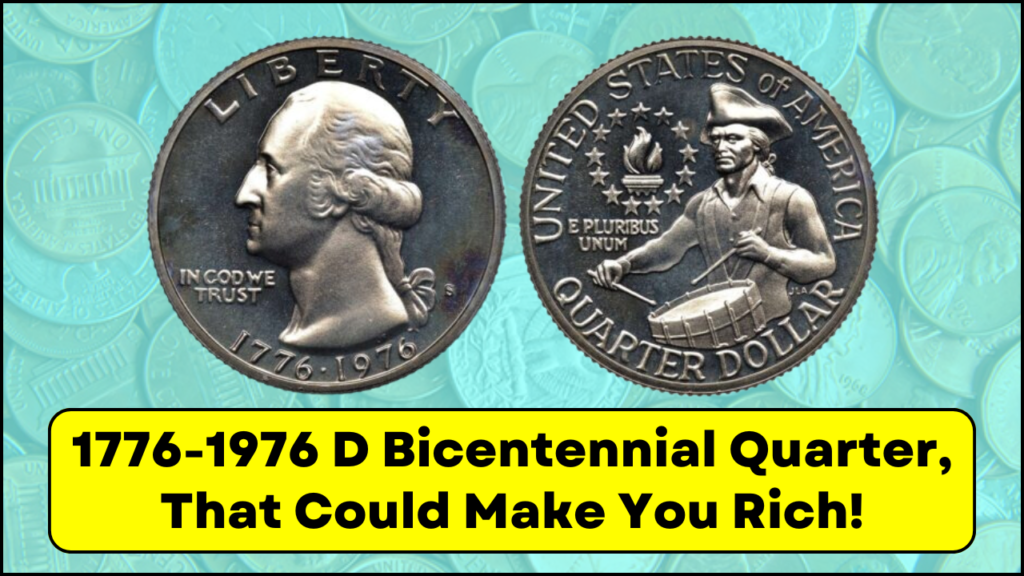
When discussing historical coins, the 1776-1976 D Bicentennial Quarter often stands out prominently. This coin was minted by the American government to commemorate the 200th anniversary of U.S. independence. With significant historical value, the 1776-1976 D Bicentennial Quarter holds a special place in the hearts of many collectors. Additionally, certain 1776-1976 D Bicentennial Quarters with unique minting errors are considered highly valuable, sometimes worth millions. Let’s explore the detailed features and significance of the 1776-1976 D Bicentennial Quarter below.
History of Bicentennial Quarter
The 1776-1976 D Bicentennial Quarter coin is regarded as a symbol of national pride in the United States. This coin, featuring the years 1776-1976, was issued to commemorate the nation’s independence. To mark this special occasion, the government instructed the mints to produce coins with unique designs.
The 1776-1976 D Bicentennial Quarter was minted during 1975 and 1976, even though the coin itself displays the years 1776-1976. The “D” on the coin signifies that it was produced at the Denver Mint. In 1976 alone, millions of these quarters were minted at the Denver facility. Additionally, the year 1976 saw the issuance of one-dollar and half-dollar coins as part of the celebration.
Unveiling the $2.2 Billion Bicentennial Quarter, Still in Circulation
Uncover the Value: Two Rare Bicentennial Quarters Worth $85 Million!
1776-1976 Quarter: Understanding Its Unique Design
The design of the 1776-1976 D Bicentennial Quarter, created by Jack L. Ahr, is a key reason for its popularity. The front side of the coin features a drummer boy in a colonial uniform. The back side of the coin includes a victory torch and 13 stars, symbolizing the original 13 colonies. The Denver Mint produced the 1776-1976 D Bicentennial Quarter with dual years, 1776-1976.
Exploring the Materials and Variants of the 1776-1976 Quarter
The 1776-1976 D Bicentennial Quarter comes in two variants or compositions.
- Only a small number of 1776-1976 D Bicentennial Quarters contain 40% silver.
- For the general public, the U.S. government mandated the copper-nickel clad composition for the 1776-1976 D Bicentennial Quarter.
1776-1976 D Bicentennial Quarter: Understanding Its Value
The 1776-1976 D Bicentennial Quarter is typically valued at 25 cents, but certain collectors are willing to pay millions for special versions of this coin. One such version is the 1776-1976 D Bicentennial Quarter that contains 40% silver, which can command higher prices due to its rarity, as only a limited number of silver coins were minted.
Additionally, coins that are in excellent condition and have been circulated less often are often valued more highly. While the standard 1776-1976 D Bicentennial Quarter has a face value of 25 cents, its specific variants and condition can significantly increase its worth.
1776-1976 D Bicentennial Quarter: Rare Variations and Minting Errors
The 1776-1976 D Bicentennial Quarter with mistakes is worth more than the regular one.
- A Clipped Planchet means part of the design is missing, which makes the coin more valuable.
- Off-Center Strikes happen when the design is not in the middle and is printed a little to the left or right.
- Double Die Errors happen when the words Liberty or In God We Trust are printed twice by mistake, making the coin more valuable.
- Die Cracks or Cuds appear when cracks in the coin die create raised areas on the coin, increasing its worth.
Identifying Valuable Bicentennial Quarters
- Check for Errors on the Coin: Look for any noticeable errors like double die, off-center marks, or die cracks that could increase its value.
- Review the Mint Mark: All 1776-1976 Bicentennial Quarters made in Denver will have a “D” mint mark.
- Assess the Coin’s Condition: Uncirculated 1776-1976 D Bicentennial Quarters typically fetch higher bids compared to circulated ones.
- Weigh the Coin: Coins made of silver will be heavier than their copper counterparts, so checking the weight is essential.
Building a Bicentennial Quarter Collection
- Collect Based on Mint Location
The Bicentennial Quarters were produced in three different mints:- D for Denver
- P for Philadelphia
- S for San Francisco
- Consider Future Value
Collecting these unique coins could be a worthwhile investment, as they may increase in value over time.
FAQs
Q1: Can the 1776-1976 D Bicentennial Quarter be worth more than face value?
Ans: Yes, rare versions or those with minting defects can be worth much more than the quarter’s original face value.
Q2: What are some common mistakes on 1776-1976 D Bicentennial Quarters?
Ans: Common errors include off-center strikes, die cracks, and doubled lettering or numbering.